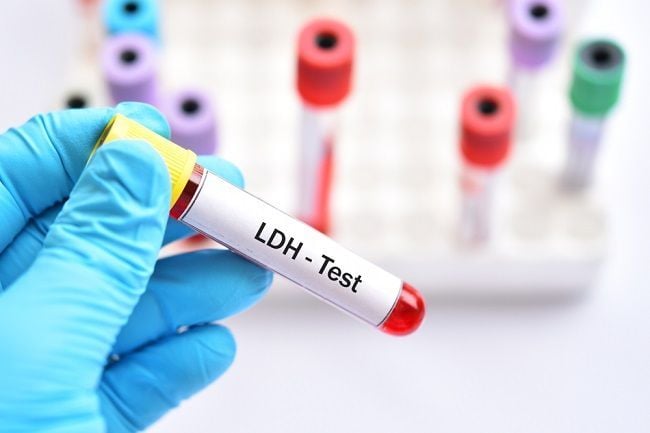LDH Blood Test: What is it Used For? - Discounted Labs

The LDH (lactate dehydrogenase) blood test measures the level of LDH in your blood. LDH is an enzyme in many body organs and tissues, including the heart, liver, muscles, and red blood cells. The LDH test is often used to help diagnose and monitor various medical conditions, such as anemia, heart attack, and liver disease. It may also be ordered to check for tissue damage or monitor treatment effectiveness for specific conditions. Since lactic dehydrogenase is present in many body tissues, its diagnostic usefulness is limited. Tissue specificity may be enhanced by LDH isoenzyme analysis.
Table of Contents
What is the Function of the LDH Blood Test?
Several different types of medical conditions can be identified and monitored with the help of a blood test called LDH. The measurements of lactate dehydrogenase levels can reveal information about the tissue and cell damage that more serious underlying diseases are causing.
A high lactate dehydrogenase level can be detected by a lactate dehydrogenase test; however, the test is unable to identify which organs are being impacted. As a consequence of this, professionals in the medical field routinely seek additional LDH isozyme tests to operate in conjunction with LDH testing in order to assist in the diagnosis of disorders. When a physician suspects that their patient is suffering from an acute or long-term sickness that is causing damage to their patient's tissues, particularly those of the heart, lungs, blood, kidney, and liver, they may frequently ask for an evaluation of the patient's LDH levels. An LDH test of the patient's body fluids is another option for determining the reason for fluid accumulation and why it occurred in the first place.
Acute illnesses manifest themselves suddenly and frequently with severe symptoms. These symptoms may point to the presence of an infection, organ failure, or an adverse reaction to a medication. Anemia, hepatitis, and liver disease are examples of chronic conditions that tend to worsen gradually over time and call for periodic testing to monitor the condition's progression. Chronic conditions can be monitored through regular monitoring. Since LDH is a nonspecific marker of cell damage, there are a variety of circumstances in which its utilization could be warranted; nonetheless, the job that it does in combination with cancer treatment is generally regarded as the most important of these. Testing for lactate dehydrogenase can be performed on individuals who have certain types of cancer, including melanoma, lymphoma, and testicular cancer, in order to determine the severity of the patient's condition and/or the patient's prognosis. Testing for LDH can also be used to monitor how well chemotherapy therapies are working in the patient's body.
How Should I Interpret My Results Now That I've Completed the LDH Test?
A small blood sample is collected in a sterile environment in order to perform an LDH test. The environment is designed to ensure patient safety. Getting ready for this blood test normally does not require any special measures to be taken. Following the completion of the examination, the patient ought to have access to the results within a few business days at the very latest. The LDH levels should be included in the test report, together with reference ranges that indicate what levels of LDH are often considered to be within a healthy range. Due to the fact that reference ranges might vary from one laboratory to another, it is critical for a healthcare provider to go over test results with their patient. When interpreting elevated levels of lactate dehydrogenase, it is necessary to take into consideration the patient's medical history, symptoms, and results from tests that were conducted in conjunction with an LDH panel. This is necessary because lactate dehydrogenase testing is not a specific diagnostic tool. An increased LDH level may indicate a number of different medical disorders, such as shock, hepatitis, medication responses, infection, anemia, muscular dystrophy, or even malignancy. An increased LDH concentration in the blood does not, by itself, offer cause for concern; nevertheless, more investigation is indicated if the increase appears in conjunction with symptoms of other disorders. Monitoring LDH levels has been shown to be an effective method for determining the course and severity of cancer. Levels of LDH that are significantly elevated to an extremely high degree may indicate a "high tumor burden," which refers to the existence of a greater number of cancer cells in the body. Additionally, LDH has the potential to act as a marker for cancer if it is frequently assessed. If LDH levels go down, this may be an indication that the malignancy is responding well to treatment.
How Accurate is the Result of My LDH Blood Test?
Although it has a wide range of applications and a host of benefits, LDH testing does have certain inherent constraints. Because LDH is present in virtually every tissue of the body, the results of additional tests are required in order to accurately pinpoint the origin of the issue. If there are no additional symptoms present, the source of the increased lactate dehydrogenase level cannot be known. In certain instances, aberrant test findings may be the outcome of circumstances in which disease was not a contributing cause. It is possible for a patient to get high test results if they engage in strenuous exercise, take prescription medications, use recreational drugs, or even if their blood sample is handled improperly. The presence of particular vitamins in the body can lead to outcomes that are below average on tests. In general, it is essential to take into consideration the patient's whole medical state as a whole, using an LDH test as only one piece of the puzzle to figure out what's going on. When interpreting the results of an LDH test, it is necessary to take the patient's medical history as well as their current symptoms into consideration. It's possible that retesting and doing some extra testing will be required in order to get a valid and accurate diagnosis. Doing so helps evaluate if an elevated LDH is simply the result of superficial tissue injury or whether something far more serious is hiding beneath the surface and waiting to be discovered.
Sources
-
Claps, G., Faouzi, S., Quidville, V., Chehade, F., Shen, S., Vagner, S., & Robert, C. (2022): “The multiple roles of LDH in cancer” published in Nature Reviews Clinical Oncology. This review highlights that serum LDH is more than a simple indicator of tumor burden; it is a complex biomarker associated with oncogenic signaling pathways, metabolic activity, invasiveness, and immunogenicity of many tumors. LDH constitutes an attractive target for cancer therapy1
-
Drent, M., Cobben, N. A., Henderson, R. F., Wouters, E. F., & van Dieijen-Visser, M. (1996): This study investigates the usefulness of lactate dehydrogenase (LDH) and its isoenzymes as indicators of lung damage or inflammation. Published in the European Respiratory Journal, it provides insights into LDH’s role in lung health2
-
Forkasiewicz, A., Dorociak, M., Stach, K., Szelachowski, P., Tabola, R., & Augoff, K. (2020): This research, published in Cellular & Molecular Biology Letters, discusses the usefulness of LDH measurements in current oncological practice. It emphasizes LDH’s role in cancer metabolism and its potential as a diagnostic and therapeutic marker3
-
Henry, B. M., Aggarwal, G., Wong, J., Benoit, S., Vikse, J., Plebani, M., & Lippi, G. (2020): In this study published in The American Journal of Emergency Medicine, elevated LDH levels predict COVID-19 severity and mortality. LDH is a valuable biomarker in assessing disease outcomes in COVID-19 patients4
-
Inamura, N., Miyashita, N., Hasegawa, S., Kato, A., Fukuda, Y., Saitoh, A., … & Ouchi, K. (2014): This research investigates the management of refractory Mycoplasma pneumoniae pneumonia. Serum LDH levels are used as parameters to determine which patients are candidates for corticosteroid therapy. Published in the Journal of Infection and Chemotherapy5
-
Jurisic, V., Radenkovic, S., & Konjevic, G. (2015): Although not directly related to the other studies, this review in Advances in Cancer Biomarkers discusses LDH as a tumor marker from biochemical and clinical aspects6









